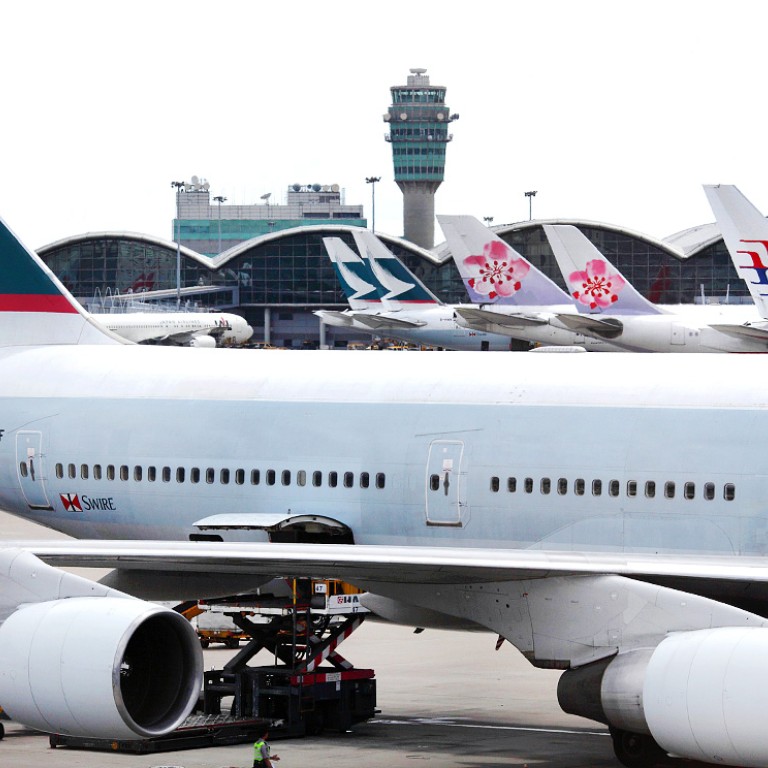
Airport Authority's incentive plan for new routes encounters turbulence
Critics say authority has been wasting money on discounts for carriers that open new routes
Doubts are hanging over the effectiveness of an Airport Authority incentive scheme to get airlines to open up new routes, as nearly half of the newly established routes are no longer in operation.

Since its launch in 2004, the scheme has approved 245 applications - but a critic says many of the new destinations were smaller mainland cities.
The authority insists the scheme is useful, but declines to say how much it has cost in the past decade.
One of its annual reports showed that in 2010 alone, the authority waived HK$50 million in landing charges under the scheme. The estimates that up to this year, at least HK$200 million in landing charges has been waived.
Just half of the new routes are still in operation, according to the authority.
The scheme's cost-effectiveness is now under question, particularly as Hong Kong debates building a third runway, estimated to cost HK$130 billion.
Michael Mo, spokesman for the Airport Development Concern Network, said the scheme led to inefficient use of the Chek Lap Kok airport.
Many of the new routes were to inland destinations on the mainland, he said, while the planes assigned to these destinations were narrow-bodied jets with a low passenger capacity.
"There are buses going directly from Hong Kong to these cities," Mo said.
"Why do we need so many small aircraft flying to these cities, using up our valuable airspace and slots so cheaply and easily?" he asked.
Joe Ng Cho-hin, vice-chairman of the Board of Airline Representatives, also questioned the incentive mechanism.
"Airlines are subsidised just by opening a new destination," Ng said. "There is a risk of them closing [the route] after a year if it does not work out. [The incentive] will be wasted."
Instead, he said, carriers should get incentives based on flight frequency rather than just by adding new destinations.
But a spokesman for the authority said: "The scheme plays a role in strengthening the airport's position as an international and regional aviation centre."
He added: "The [authority] has no power to decide people's travel patterns, nor how airlines would like to carry their passengers or cargo."
In good years, landing, parking and route expenses account for about 15 per cent of an airline's operating costs.
The scheme was first introduced in 2001, but was shelved a year later. It was resurrected in 2004 amid Hong Kong's eagerness to restore its reputation as a world-class aviation hub following a bruising battle with severe acute respiratory syndrome.
Under the scheme, airlines can get a year of rebates on landing charges - 75 per cent in the first six months and 25 per cent for the remainder of the year.
Landing charges at Chek Lap Kok are among the lowest in the world and have not been adjusted since the airport opened in 1998.
Professor Michael Fung Ka-yiu of Chinese University's Aviation Policy and Research Centre, questioned whether the scheme was a failure.
"If you think about it, flights to all major destinations already exist," he said. "It is all about testing the market and stimulating demand [for new destinations] before competitors move in."
Aviation industry consultant Henry Chan Hin-lee agreed. "The simple fact is that every airport wants to become a hub because connecting flights help grow the network. Relying on local passengers is simply not enough."
But Chan said the scheme should be reviewed and revised to reduce wastage.
Chek Lap Kok's biggest rival in the region - Singapore's Changi Airport - will start to provide all airlines a 10 per cent discount on landing fees from next month until March 2016.
Changi Airport already offers a variety of incentives to airlines for opening up new destinations. It has added 20 new cities to its network over the past two years, with nearly half of them mainland cities.

